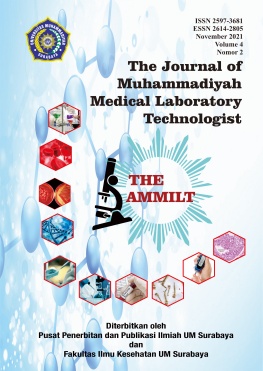Isi Artikel Utama
Abstrak
Candidiasis is one of the most common infectious diseases caused by Candida sp. In 2017 the Mycology Division of Dr. Soetomo said there were 67 patients diagnosed with candidiasis. The use of natural ingredients as an alternative to traditional medicine is increasing because it is safe for consumption and does not cause side effects. One of the natural ingredients is Ginger (Zingiber officinale). The choice of using ginger juice (Zingiber officinale) is because the ingredients are easy to obtain and easy to apply by the community. This study aims to determine the antifungal effectiveness of ginger (Zingiber officinale) juice against the growth of Candida albicans. This research is experimental by doing the treatment which was repeated 4 times, namely the concentration of ginger juice 20%, 40%, 60%, 80%, 100%, negative control (aquadest) and positive control (ketoconazole). The inhibition zone examination method used the Kirby Bauer diffusion method which was characterized by the formation of a clear zone around the paper disc on MHA (Muller Hinton Agar) media. The inhibition zone formed was measured using a caliper, then the data obtained were analyzed using the Mann-Whitney test. From laboratory examination, it was found that the average diameter of inhibition formed with concentrations of 20%, 40%, 60%, 80%, and 100% was 0 mm, and the negative control (aquadest) was 0 mm. The results of statistical analysis showed that 0.05 obtained a significant value between the administration of juice concentrations of 20%, 40%, 60%, 80%, 100% and not given (negative control-aquadest) = 1,000. From these results, it was concluded that there was no significant difference between the concentrated juice of 20%, 40%, 60%, 80%, 100% and not given (negative control - distilled water)
Keywords : Ginger (Zingiber officinale), Candida albicans
Rincian Artikel
Referensi
- Al-Oebady, M. A. H. (2015). Isolation and identification of Candida species from vaginal, urine and oral swabs by chromagar Candida. International Journal of Advanced Research. vol. 3, no 1, hal. 948 – 956
- Aryanta, I. W. (2019). Manfaat Jahe Untuk Kesehatan. Profil Kesehatan Ayurweda. vol 1, no , 40
- Kaban, AN., Daniel., Saleh C. (2016). Uji Fitokimia, Toksisitas dan Aktivitas Antioksidan Fraksi n-heksan Dan Etil Asetat terhadap Ekstrak Jahe Merah (Zingiber officinale var. amarum.). Jurnal Kimia Mulawarman. Volume 14 Nomer 1
- Khumairoh, I. S.(2018). Uji Aktivitas Antifungi Lengkuas Merah (Alpinia Purpurata), Kunyit (Curcuma Longa), Dan Jahe (Zingiber Officinale) Terhadap candida Albicans. skripsi , Universitas Islam Negeri Sunan Ampel, Surabaya
- Masloman, AP., Pangemanan, DHC., Anindita, PS. (2016). Uji daya hambat ekstrak daun sirsak (Annona murcata l.) Terhadap pertumbuhan jamur Candida albicans. PHARMACON Jurnal Ilmiah Farmasi – UNSRAT Vol. 5 No. 4
- Mitchell TG. (2013) Medical Mycology. In: Jawetz, Melnic, Adelber, eds. MicrobiologÃa médica. México: McGrawHill Press; 2013. p. 671-713
- Mutiawati, V.K. (2016). Pemeriksaan Mikrobiologi pada Candida albicans. Jurnal Kedokteran Syiah Kuala. vol. 16 no. 1
- Nacsa, E. F., Eliza, K., Eriak, B. K., Judit, K., Popescu, R., Daliborca, C. V., Pauliuc I, Csaba, V. (2014). Antifungal Effect Of Selected European Herbs Against Candida Albicans And Emerging Pathogenic Non-Albicans Candida Species. Acta Biologica Szegediensis .vol. 58, no. 1
- Puspitasari A, Kawilarang AP, Ervianti E, Rohiman A. (2019). Profil Pasien Baru Kandidiasis. Berkala Ilmu Kesehatan Kulit dan Kelamin – Periodical of Dermatology and Venereology Vol. 31 / No. 1
- Surani dan Novizel Putri (2018). Efektifitas Anti Jamur Campuran Rebusan Jahe (Zingiber Officinale) Dan Kunyit (Curcuma Domestica) Terhadap Pertumbuhan Candida albicans. Prosiding Seminar Kesehatan Peritis. vol. 1, no. 2
- Widaty S. (2016) Dermatomikosis superfisial. Ilmu Penyakit Kulit dan Kelamin. Jakarta: Balai Penerbit FK UI;. p. 117-20
Referensi
Al-Oebady, M. A. H. (2015). Isolation and identification of Candida species from vaginal, urine and oral swabs by chromagar Candida. International Journal of Advanced Research. vol. 3, no 1, hal. 948 – 956
Aryanta, I. W. (2019). Manfaat Jahe Untuk Kesehatan. Profil Kesehatan Ayurweda. vol 1, no , 40
Kaban, AN., Daniel., Saleh C. (2016). Uji Fitokimia, Toksisitas dan Aktivitas Antioksidan Fraksi n-heksan Dan Etil Asetat terhadap Ekstrak Jahe Merah (Zingiber officinale var. amarum.). Jurnal Kimia Mulawarman. Volume 14 Nomer 1
Khumairoh, I. S.(2018). Uji Aktivitas Antifungi Lengkuas Merah (Alpinia Purpurata), Kunyit (Curcuma Longa), Dan Jahe (Zingiber Officinale) Terhadap candida Albicans. skripsi , Universitas Islam Negeri Sunan Ampel, Surabaya
Masloman, AP., Pangemanan, DHC., Anindita, PS. (2016). Uji daya hambat ekstrak daun sirsak (Annona murcata l.) Terhadap pertumbuhan jamur Candida albicans. PHARMACON Jurnal Ilmiah Farmasi – UNSRAT Vol. 5 No. 4
Mitchell TG. (2013) Medical Mycology. In: Jawetz, Melnic, Adelber, eds. MicrobiologÃa médica. México: McGrawHill Press; 2013. p. 671-713
Mutiawati, V.K. (2016). Pemeriksaan Mikrobiologi pada Candida albicans. Jurnal Kedokteran Syiah Kuala. vol. 16 no. 1
Nacsa, E. F., Eliza, K., Eriak, B. K., Judit, K., Popescu, R., Daliborca, C. V., Pauliuc I, Csaba, V. (2014). Antifungal Effect Of Selected European Herbs Against Candida Albicans And Emerging Pathogenic Non-Albicans Candida Species. Acta Biologica Szegediensis .vol. 58, no. 1
Puspitasari A, Kawilarang AP, Ervianti E, Rohiman A. (2019). Profil Pasien Baru Kandidiasis. Berkala Ilmu Kesehatan Kulit dan Kelamin – Periodical of Dermatology and Venereology Vol. 31 / No. 1
Surani dan Novizel Putri (2018). Efektifitas Anti Jamur Campuran Rebusan Jahe (Zingiber Officinale) Dan Kunyit (Curcuma Domestica) Terhadap Pertumbuhan Candida albicans. Prosiding Seminar Kesehatan Peritis. vol. 1, no. 2
Widaty S. (2016) Dermatomikosis superfisial. Ilmu Penyakit Kulit dan Kelamin. Jakarta: Balai Penerbit FK UI;. p. 117-20

